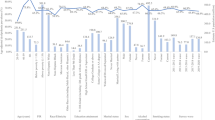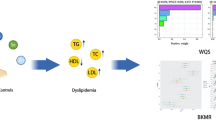Abstract
Our objective was to evaluate the relationship of blood metal levels including strontium, cadmium, lead, vanadium, aluminum, cobalt, and manganese with dyslipidemia in the elderly Chinese population. In this study, stratified cluster sampling was adopted in the elderly in two communities of Lu’an City from June to September 2016, and 1013 participants were finally included. The inductively coupled plasma mass spectrometry (ICP-MS) was used to measure the metals’ concentrations in whole blood. After multivariable adjustment, the odds ratios (95% confidence interval [CI]) of dyslipidemia associated with the highest quartile of metal concentrations were 1.32 (0.89 ~ 1.96), 1.28 (0.83 ~ 1.97), 1.86 (1.23 ~ 2.80), 0.80 (0.55 ~ 1.16), 0.76 (0.51 ~ 1.13), 0.76 (0.53 ~ 1.11), and 1.14 (0.78 ~ 1.67) for strontium, cadmium, lead, vanadium, aluminum, cobalt, and manganese, respectively, compared with the lowest quartile. After reducing the dimensionality of metal elements by principal component analysis, we found that the combined exposure of aluminum, cobalt, and vanadium was the protective factor of non-dyslipidemia, while the combined exposure of cadmium, strontium, and lead was the risk factor of dyslipidemia.
Similar content being viewed by others
References
Arca M, Montali A, Valiante S, Campagna F, Pigna G, Paoletti V, Antonini R, Barilla F, Tanzilli G, Vestri A, Gaudio C (2007) Usefulness of atherogenic dyslipidemia for predicting cardiovascular risk in patients with angiographically defined coronary artery disease. Am J Cardiol 100(10):1511–1516. https://doi.org/10.1016/j.amjcard.2007.06.049
Zhu JR, Gao RL, Zhao SP, Lu GP, Zhao D, Li JJ, Chen WW, Ma LY (2018) 2016 Chinese guideline for the management of dyslipidemia in adults. J Geriatr Cardiol 15(1):1–29. https://doi.org/10.11909/j.issn.1671-5411.2018.01.011
Jeong JS, Kwon HS (2017) Prevalence and clinical characteristics of dyslipidemia in Koreans. Endocrinol Metab (Seoul) 32(1):30–35. https://doi.org/10.3803/EnM.2017.32.1.30
Gupta R, Rao RS, Misra A, Sharma SK (2017) Recent trends in epidemiology of dyslipidemias in India. Indian Heart J 69(3):382–392. https://doi.org/10.1016/j.ihj.2017.02.020
Lin CF, Chang YH, Chien SC, Lin YH, Yeh HY (2018) Epidemiology of dyslipidemia in the Asia Pacific Region. Int J Gerontol 12(1):2–6. https://doi.org/10.1016/j.ijge.2018.02.010
Cho IY, Park HY, Lee K, Bae WK, Jung SY, Ju HJ, Song JK, Han JS (2017) Association between the awareness of dyslipidemia and health behavior for control of lipid levels among Korean adults with dyslipidemia. Korean J Fam Med 38(2):64–74. https://doi.org/10.4082/kjfm.2017.38.2.64
Ghandehari H, Kamal-Bahl S, Wong ND (2008) Prevalence and extent of dyslipidemia and recommended lipid levels in US adults with and without cardiovascular comorbidities: the National Health and Nutrition Examination Survey 2003–2004. Am Heart J 156(1):112–119. https://doi.org/10.1016/j.ahj.2008.03.005
Kah M, Levy L, Brown C (2012) Potential for effects of land contamination on human health. 1. The case of cadmium. J Toxicol Environ Health B 15(5):348–363. https://doi.org/10.1080/10937404.2012.705107
Stohs S, Bagchi D (1995) Oxidative mechanisms in the toxicity of metal ions. Free Radic Biol Med 18(2):321–336. https://doi.org/10.1016/0891-5849(94)00159-H
Valko M, Morris H, Cronin MTD (2005) Metals, toxicity and oxidative stress. Curr Med Chem 12(10):1161–1208. https://doi.org/10.2174/0929867053764635
Hultberg B, Andersson A, Isaksson A (2001) Interaction of metals and thiols in cell damage and glutathione distribution_ potentiation of mercury toxicity by dithiothreitol. Toxicology 156(2-3):93–100. https://doi.org/10.1016/s0300-483x(00)00331-0
Quig D (1998) Cysteine metabolism and metal toxicity. Altern Med Rev 3(4):262–270
Satarug S, Moore MR (2004) Adverse health effects of chronic exposure to low-level cadmium in foodstuffs and cigarette smoke. Environ Health Perspect 112(10):1099–1103. https://doi.org/10.1289/ehp.6751
Crinnion WJ (2010) The CDC fourth national report on human exposure to environmental chemicals: what it tells us about our toxic burden and how it assist environmental medicine physicians. Altern Med Rev 15(2):101–109
Mari M, Nadal M, Schuhmacher M, Barberia E, Garcia F, Domingo JL (2014) Human exposure to metals: levels in autopsy tissues of individuals living near a hazardous waste incinerator. Biol Trace Elem Res 159(1-3):15–21. https://doi.org/10.1007/s12011-014-9957-z
Rovira J, Nadal M, Schuhmacher M, Domingo JL (2015) Human exposure to trace elements through the skin by direct contact with clothing: risk assessment. Environ Res 140(1):308–316. https://doi.org/10.1016/j.envres.2015.03.032
Esteban-Vasallo MD, Nuria A, Marina P, Gonzalo LA, Beatriz PG (2012) Mercury, cadmium, and lead levels in human placenta: a systematic review. Environ Health Perspect 120(10):1369–1377. https://doi.org/10.1289/ehp.1204952
Alves RI, Sampaio CF, Nadal M, Schuhmacher M, Domingo JL, Segura-Muñoz SI (2014) Metal concentrations in surface water and sediments from Pardo River, Brazil: human health risks. Environ Res 133(2):149–155. https://doi.org/10.1016/j.envres.2014.05.012
Rahmani J, Fakhri Y, Shahsavani A, Bahmani Z, Urbina MA, Chirumbolo S, Keramati H, Moradi B, Bay A, Bjorklund G (2018) A systematic review and meta-analysis of metal concentrations in canned tuna fish in Iran and human health risk assessment. Food Chem Toxicol 118(1):753–765. https://doi.org/10.1016/j.fct.2018.06.023
Cosselman KE, Navas-Acien A, Kaufman JD (2015) Environmental factors in cardiovascular disease. Nat Rev Cardiol 12(11):627–642. https://doi.org/10.1038/nrcardio.2015.152
Alissa EM (2011) Ferns GA (2011) Heavy metal poisoning and cardiovascular disease. Toxicol 2011:1–21. https://doi.org/10.1155/2011/870125
Bushnik T, Levallois P, D’Amour M, Anderson TJ, Mcalister FA (2014) Association between blood lead and blood pressure: results from the Canadian Health Measures Survey (2007 to 2011). Health Rep 25(7):12–22
Organization WH (1998) Guidelines for controlling and monitoring the tobacco epidemic. https://doi.org/10.1177/146642409911900119
Association AD (2012) Diagnosis and classification of diabetes mellitus. Diabetes Care 35(1):S64–S71. https://doi.org/10.2337/dc09-S062
Liu LS (2011) 2010 Chinese guidelines for the management of hypertension. Chin J Hypertens 39(2):579–615. https://doi.org/10.3760/cma.j.issn.0253-3758.2011.07.002
Prevention JCfDCgo (2007) Chinese guidelines on prevention and treatment of dyslipidemia in adults. Zhonghua Xin Xue Guan Bing Za Zhi 35(5):390–419. https://doi.org/10.3760/j.issn:0253-3758.2007.05.003
Liu X, Yu S, Mao Z, Li Y, Zhang H, Yang K, Zhang H, Liu R, Qian X, Li L, Bie R, Wang C (2018) Dyslipidemia prevalence, awareness, treatment, control, and risk factors in Chinese rural population: the Henan rural cohort study. Lipids Health Dis 17(1):119–131. https://doi.org/10.1186/s12944-018-0768-7
Song P, Zha M, Yang X, Xu Y, Wang H, Fang Z, Yang X, Xia W, Zeng C (2019) Socioeconomic and geographic variations in the prevalence, awareness, treatment and control of dyslipidemia in middle-aged and older Chinese. Atherosclerosis 282(1):57–66. https://doi.org/10.1016/j.atherosclerosis.2019.01.005
Huang Y, Lin G, Xie X, Seng CT (2014) Epidemiology of dyslipidemia in Chinese adults: meta-analysis of prevalence, awareness, treatment, and control. Popul Health Metrics 12(1):28–35. https://doi.org/10.1186/s12963-014-0028-7
Kim Y, Suh YK, Choi H (2004) BMI and metabolic disorders in South Korean adults: 1998 Korea National Health and Nutrition Survey. Obes Res 12(3):445–453. https://doi.org/10.1038/oby.2004.50
Brown CD, Higgins M, Donato KA, Rohde FC, Garrison R, Obarzanek E, Ernst ND, Horan M (2012) Body mass index and the prevalence of hypertension and dyslipidemia. Obes Res 8(9):605–619. https://doi.org/10.1038/oby.2000.79
Barceloux DG (1999) Vanadium. Clin Toxicol 37(2):265–278
Shahi MM, Haidari F, Shiri MR (2011) Comparison of effect of resveratrol and vanadium on diabetes related dyslipidemia and hyperglycemia in streptozotocin induced diabetic rats. Adv Pharm Bull 1(2):81–86. https://doi.org/10.5681/apb.2011.012
Walton JR (2007) An aluminum-based rat model for Alzheimer’s disease exhibits oxidative damage, inhibition of PP2A activity, hyperphosphorylated tau, and granulovacuolar degeneration. J Inorg Biochem 101(9):1275–1284. https://doi.org/10.1016/j.jinorgbio.2007.06.001
Nayak P (2002) Aluminum: impacts and disease. Environ Res 89(2):101–115. https://doi.org/10.1006/enrs.2002.4352
Ryan M, Joseph L, Vasu A (2007) Aluminum-induced mitochondrial dysfunction leads to lipid accumulation in human hepatocytes: a link to obesity. Cell Physiol Biochem 20(5):627–638. https://doi.org/10.1159/000107546
Mailloux RJ, Hamel R, Appanna VD (2010) Aluminum toxicity elicits a dysfunctional TCA cycle and succinate accumulation in hepatocytes. Biochem Mol Toxicol 20(4):198–208. https://doi.org/10.1002/jbt.20137
Vilarinho KA, de Oliveira PP, Saad MJ, Eghtesady P, Filho LM, Vieira RW, Petrucci O (2013) Erythropoietin protects the systolic function of neonatal hearts against ischaemia/reperfusion injury. Eur J Cardiothorac Surg 43(1):156–162. https://doi.org/10.1093/ejcts/ezs254
Ladoux A, Frelin C (1994) Cobalt stimulates the expression of vascular endothelial growth factor mRNA in rat cardiac cells. Biochem Biophys Res Commun 204(2):794–798. https://doi.org/10.1006/bbrc.1994.2529
Alissa EM, Bahijri SM, Lamb DJ, Ferns GAA (2004) The effects of coadministration of dietary copper and zinc supplements on atherosclerosis, antioxidant enzymes and indices of lipid peroxidation in the cholesterol-fed rabbit. Int J Exp Pathol 85(5):265–275. https://doi.org/10.1111/j.0959-9673.2004.00392.x
Kaliman PA, Shalamov RV, Zagaiko AL (1997) Effect of cobalt chloride on content of lipids and lipoproteins in serum and liver of rats. Biochemistry 62(7):725–731. https://doi.org/10.1021/bi9703960
Qu KG, Zhao CQ, Ren JS, Qu XG (2012) Human telomeric G-quadruplex formation and highly selective fluorescence detection of toxic strontium ions. Mol BioSyst 8(3):779–782. https://doi.org/10.1039/c2mb05446a
Godt J, Scheidig F, Grosse-Siestrup C, Esche V, Brandenburg P, Reich A, Groneberg DA (2006) The toxicity of cadmium and resulting hazards for human health. J Occup Med Toxicol 1(1):22. https://doi.org/10.1186/1745-6673-1-22
Planchart A, Green A, Hoyo C, Mattingly CJ (2018) Heavy metal exposure and metabolic syndrome: evidence from human and model system studies. Curr Environ Health Rep 5(1):110–124. https://doi.org/10.1007/s40572-018-0182-3
Wolf MB, Baynes JW (2007) Cadmium and mercury cause an oxidative stress-induced endothelial dysfunction. Biometals 20(1):73–81. https://doi.org/10.1007/s10534-006-9016-0
Kelishadi R, Askarieh A, Motlagh ME, Tajadini M, Heshmat R, Ardalan G, Fallahi S, Poursafa P (2013) Association of blood cadmium level with cardiometabolic risk factors and liver enzymes in a nationally representative sample of adolescents: the CASPIAN-III study. Environ Public Health 2013(1):1–5. https://doi.org/10.1155/2013/142856
Ademuyiwa O, Ugbaja RN, Idumebor F, Adebawo O (2005) Plasma lipid profiles and risk of cardiovascular disease in occupational lead exposure in Abeokuta, Nigeria. Lipids Health Dis 4(1):19. https://doi.org/10.1186/1476-511X-4-19
Kamal M, Fathy MM, Taher E, Hasan M, Tolba M (2011) Assessment of the role of paraoxonase gene polymorphism (Q192R) and paraoxonase activity in the susceptibility to atherosclerosis among lead-exposed workers. Ann Saudi Med 31(5):481–487. https://doi.org/10.4103/0256-4947.84625
Li WF, Pan MH, Chung MC, Ho CK, Chuang HY (2006) Lead exposure is associated with decreased serum paraoxonase 1 (PON1) activity and genotypes. Environ Health Perspect 114(8):1233–1236.https://doi.org/10.1289/ehp.9163
Schramm VL, Wedler FC (1994) Preface - manganese in metabolism and enzyme function. Manganese in Metabolism & Enzyme Function 23(1):103–121. https://doi.org/10.1021/ba-1994-0242.pr001
Klimis-Tavantzis DJ, Leach RMJ, Kris-Etherton PM (1983) The effect of dietary manganese deficiency on cholesterol and lipid metabolism in the Wistar rat and in the genetically hypercholesterolemic RICO rat. J Nutr 113(2):328–336. https://doi.org/10.1093/jn/113.2.328
Rognstad R (1981) Manganese effects on gluconeogenesis. Biol Chem 256(4):1608–1610. https://doi.org/10.1016/0165-022X(81)90075-0
Burlet E (2014) Manganese supplementation as an adjuvant therapy for preventing endothelial dysfunction in type 2 diabetes. Dissertations & Theses - Gradworks 20(10):1465–1484. https://doi.org/10.1016/j.bbmt.2014.04.010
Acknowledgments
The authors are grateful to all people who contributed to this study, including the Anhui Provincial Center for Disease Control and Prevention, the Lu’an Jin’an Center for Disease Control and Prevention, the Lu’an Yuan Center for Disease Control and Prevention, Chengbei Township Health Center, and Beishi Community Health Service Center, an experimental center for public health, Anhui Medical University.
Funding
This study was supported by the National Natural Science Foundation of China (No. 81102125). The sponsor was involved in the design, data collection, and analysis of the study and is the corresponding author of this article.
Author information
Authors and Affiliations
Contributions
Xingmeng Zhu and Yong Fan participated in the data analysis and drew up the manuscript. Yong Fan, Ling Gu, Qi Tao, Rui Huang, Kaiyong Liu, Guimei Chen, Linsheng Yang, Hongjuan Cao, Kaichun Li, and Fangbiao Tao participated in the epidemiological surveys, sample collection, and data entry. Xingmeng Zhu, Jie Sheng, and Yong Fan performed the experiments. Sufang Wang participated in the design and conducted the study. All authors read and approved the final manuscript.
Corresponding author
Ethics declarations
Conflict of Interest
The authors declare that they have no conflict of interest.
Ethical Approval
This study was approved by the Biomedical Ethics Committee of Anhui Medical University.
Statement of Informed Consent
All participants signed an informed consent form.
Additional information
Publisher’s Note
Springer Nature remains neutral with regard to jurisdictional claims in published maps and institutional affiliations.
Electronic supplementary material
ESM 1
(DOCX 33. 5 kb)
Rights and permissions
About this article
Cite this article
Zhu, X., Fan, Y., Sheng, J. et al. Association Between Blood Heavy Metal Concentrations and Dyslipidemia in the Elderly. Biol Trace Elem Res 199, 1280–1290 (2021). https://doi.org/10.1007/s12011-020-02270-0
Received:
Accepted:
Published:
Issue Date:
DOI: https://doi.org/10.1007/s12011-020-02270-0




